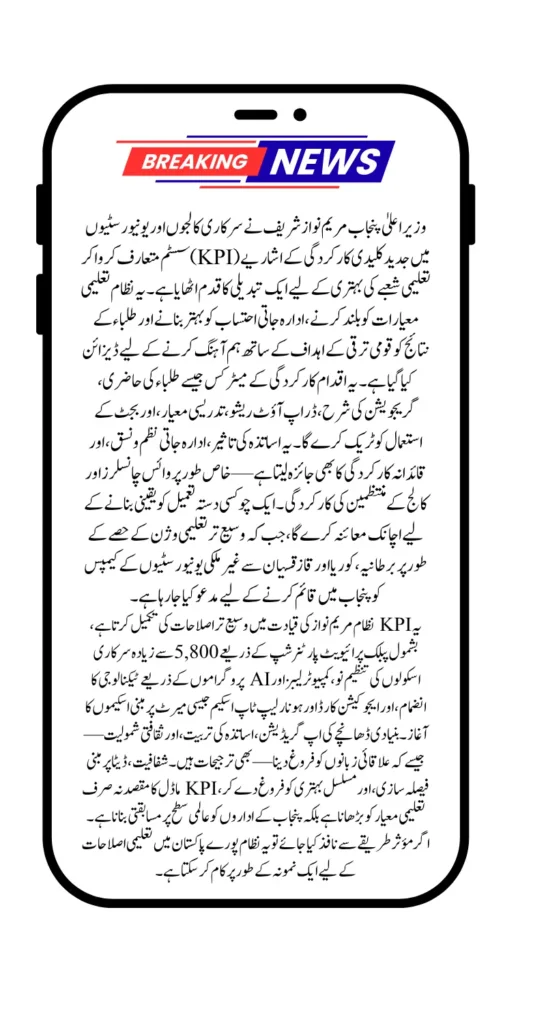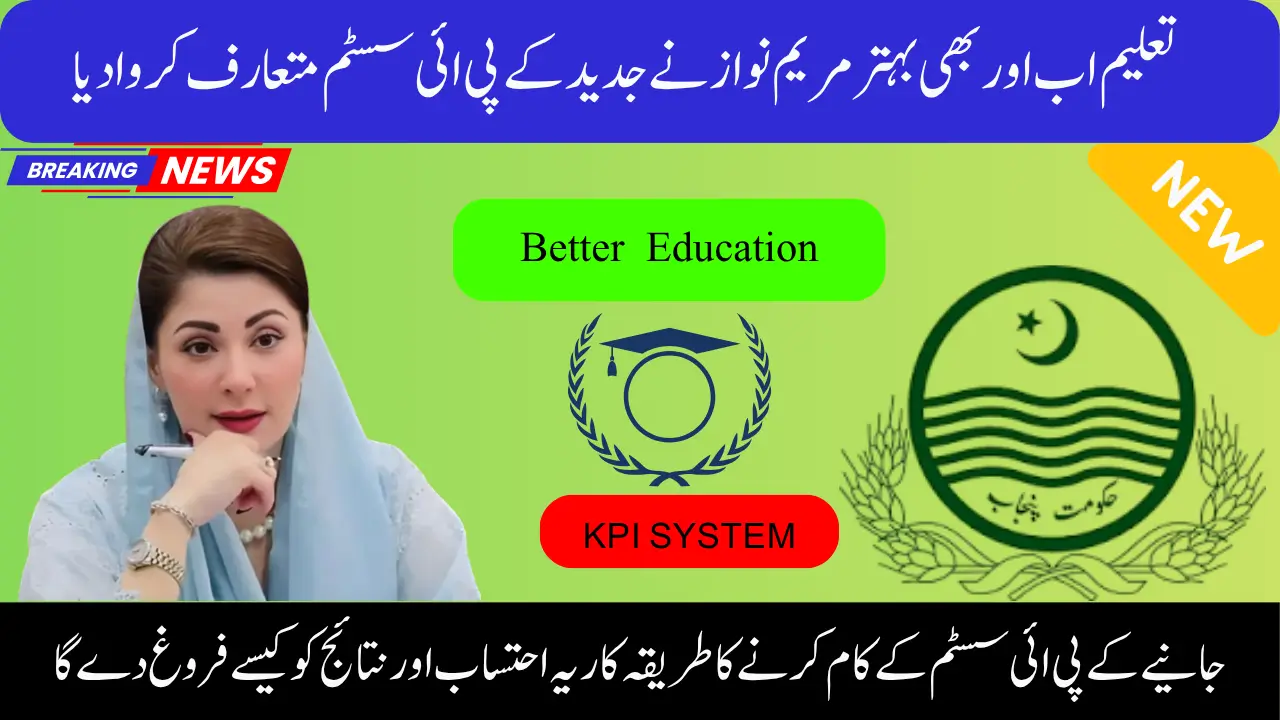Modern KPIs in Education
Punjab Chief Minister Maryam Nawaz Sharif launched various programs to develop Punjab and expanded many programs. Along with this, unsustainable programs were also discontinued and sustainable programs that were environment-friendly were introduced in their place.
Now, Prime Minister Maryam Nawaz Sharif has adopted a strategy to raise the standard of education and decided to introduce the KPI system so that educational standards can be further raised and students can be introduced to everything that is necessary for it and put them on a straight track so that they can stick to their goals and fulfill their goals and dreams.
Along with this, they can gain their place in society. Chief Minister Maryam Nawaz also gave another directive that a camp of foreign universities should be established in Punjab, including the campuses of universities from Britain, Korea and Kazakhstan in Punjab. She has also decided to introduce a modern KPI system.
Today, in this article, we will be able to know what the KPI system is, how it works, what its benefits will be and what its effects will be on the environment. While how it will improve the performance of children and how it will make teachers practical and set an example for children, today we will get all the information about the KPI system in this article.
New Installment of BISP 13500 Released! Is Payment Possible Without Biometrics?
What is KPI System
A KPI (Key Performance Indicator) system is a framework used to measure and evaluate the performance of an organization, team, or individual. It involves setting specific, measurable, achievable, relevant, and time-bound (SMART) goals and tracking progress towards these goals.
In Education
The implementation of a Key Performance Indicator (KPI) system aimed at raising the quality of education in government universities and colleges of Punjab represents a historic effort towards accountability, institutional modernization, and academic excellence.
The new KPI mechanism mandates the evaluation of public university and college administration—including vice-chancellors—on quantifiable metrics. Areas under evaluation include:
- Teaching quality
- Institutional development
- Student outcomes and success rates
- Promote institutional autonomy and reforms
- Encourage international academic collaborations
This approach introduces transparency and performance-based governance in public higher education.
By holding administrators to specific standards and increasing transparency, the system is expected to drive continuous improvement across the sector.
Electric Trams in Lahore? Yes! Here’s the Big Announcement You Missed.
Types of KPIs in Education
Key Performance Indicators i.e. KPIs will help to describe the performance of students in a good way, such as;
- The standard score obtained in the test,
- The rate of students graduating,
- The rate of how many students dropped out of school
- And how many courses completed in a certain way and time.

This is the KPI system for children in terms of education, while the KPI system will cover all things in education.
The KPI system will also describe the performance of teachers. The evaluation rating of all teachers. The evaluation of teacher progress i.e.
- How many children showed good performance?
- The rate of retention of progress.
- The retention rate of teachers.
To show the performance of the school and the district, the KPI will show these things.
- The rate of children enrolled in school.
- The rate of children attending school.
- The rate of graduation.
- The rate of budget and expenditure.
KPI systems will bring all things into one system and cover all things and will enable us to adapt our situations and events according to the rate and develop well.
Benefits of KPIs in Education
Improved student outcomes:
KPIs help teachers identify areas where students need additional support, enabling targeted interventions.
Data-driven decision-making:
KPIs provide insights that inform instructional strategies, resource allocation, and policy decisions.
Accountability:
KPIs promote transparency and accountability among teachers, administrators, and policymakers.
Increased teacher efficacy:
KPIs help teachers identify areas for professional growth and development.
KPI System Overview
University Leaders
The performance of the university leaders will assessed through their KPI criteria, which include research output, teaching innovation, governance reforms and academic progress, etc.
College Management Councils
Public colleges will managed by locally led management councils under the leadership and will be tasked with improving operations, governance and performance measurement.
Vigilance Squad
A team will nominated to monitor them, which will have all the powers and will want to inspect colleges and universities without giving any reason, that is, without announcing why, the aim will to review cleanliness, attendance of children, delivery of education, infrastructure and other factors. If there is no fault in their system, it will not fined or closed, whereas if any fault is found, the college or university will fined and it will brought to a standstill and its correctness will ensured.
Reforms and support for broader education
The KPI system complements a set of reforms initiated under Maryam Nawaz’s leadership, including:
Public Schools Reorganization Program (PSRP)
Over 5,800 schools have outsourced through public-private partnerships, resulting in cleaner facilities, better infrastructure, and increased teacher training. Enrollment increased, the number of teachers nearly doubled, and the student-teacher ratio became more favorable.
Technology-enabled education
Digital transformation remains a priority. Schools are being equipped with state-of-the-art computers, Wi-Fi access is being expanded, and vocational and technical education is being introduced from the primary level. Initiatives include AI piloting, computer labs, and tech-focused curricula.
Scholarships and incentives
Milestone schemes like the Education Card and the Honaar/Laptop Scheme provide merit-based rewards to high-performing students. More than 19,000 applicants from other provinces have expressed interest in Punjab’s laptop scheme alone.
Infrastructure and safety measures
Unsafe school buildings have sealed and renovated. New classrooms, science labs, and sanitation facilities have constructed. Additional programs in early childhood and special education have also received considerable attention.
Cultural and language inclusion
Chief Minister Maryam has also supported initiatives to promote regional languages like Punjabi, along with professional programs in the arts, character building, and student competitions.
Final Words
The KPI system is an important tool in evaluating and improving the performance of educational institutions and it can play an important role in the development of Pakistan by making them better in the future. KPI collects and analyzes the required data and helps in decision-making, which leads to the use of insight and it is an important tool in helping teachers and other students succeed. Keeping these objectives in mind, we can say that the KPI system can make the educational environment even more effective if we implement it well and understand its mechanism.
Complete Method to Check CNIC Eligibility Through 8171 SMS and Website
